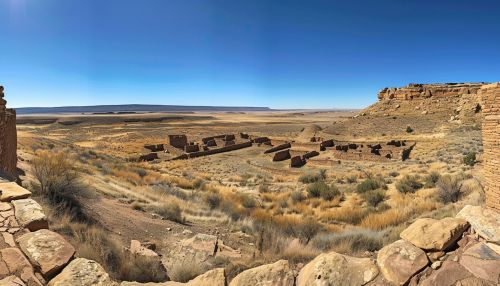Chaco Culture National Historical Park
Overview
Chaco Culture National Historical Park is a United States National Historical Park hosting the densest and most exceptional concentration of pueblos in the American Southwest. The park is located in northwestern New Mexico, between Albuquerque and Farmington, in a remote canyon cut by the Chaco Wash. Containing the most sweeping collection of ancient ruins north of Mexico, the park preserves one of the most important pre-Columbian cultural and historical areas in the United States.


Geography
The park lies in the San Juan Basin, at an elevation of about 6,200 feet, and covers an area of 33,977 acres. The park is surrounded by the high mesas and desert scrublands of the Colorado Plateau. The canyon itself, also known as Chaco Canyon, is 10 miles long and ranges from 0.25 to 0.75 miles wide. The canyon's walls are lined with ancient pueblo structures, some of which are among the largest in the region.
History
The history of Chaco Culture National Historical Park is a complex web of archaeology, geology, and anthropology. The area was inhabited by the Ancient Pueblo Peoples, also known as the Anasazi, who left behind extensive ruins and artifacts. The park's largest pueblo, Pueblo Bonito, is composed of around 600 rooms and is thought to have been the center of the Chacoan world.
Archaeology
The park is home to numerous archaeological sites, including the ruins of ancient dwellings known as "Great Houses". These structures were built by the Ancient Pueblo Peoples between AD 850 and 1250. The park's archaeological sites offer a glimpse into the sophisticated culture of the Ancient Pueblo Peoples, who were skilled architects, engineers, and astronomers.
Flora and Fauna
The park's flora is characterized by a high desert ecosystem with a variety of plant species, including sagebrush, juniper, and piñon pine. The fauna includes a diverse range of species, from small mammals and birds to larger animals like coyotes and mule deer.
Tourism
The park offers a range of activities for visitors, including hiking, camping, and guided tours of the ancient ruins. The park's visitor center provides interpretive exhibits on the Chacoan people, their architecture, and their relationship with the Chaco landscape.
Conservation
The park is managed by the National Park Service, which works to preserve the archaeological sites and natural resources of the park. The park has been designated a World Heritage Site by UNESCO, recognizing its universal cultural value.
